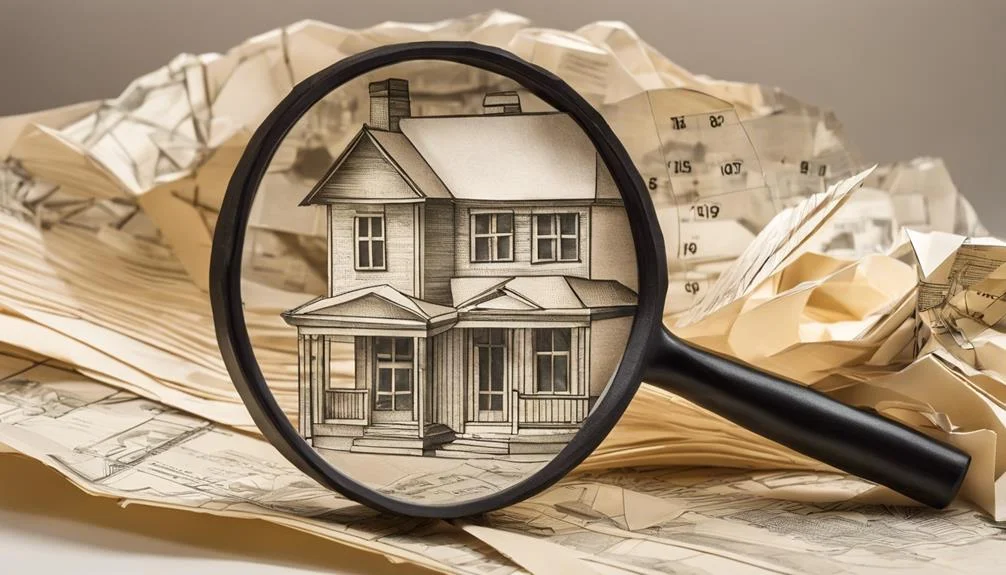Navigating the intricacies of locating old real estate listing photos can often seem like an endeavor shrouded in mystery. Whether for historical interest, market analysis, or personal reasons, the task demands a nuanced approach, combining modern technological tools with traditional research methods.
By strategically leveraging search engines, accessing real estate portals, and consulting public records, one can uncover layers of property history not readily visible on the surface. Yet, the journey does not end with these steps alone.
The potential to unearth valuable insights and hidden gems within these archives invites further exploration, promising to reveal more than just images for those willing to pursue the path less traveled.
Key Takeaways
- Utilize search engines and real estate platforms like Zillow, Trulia, and Redfin for accessing historical listing photos.
- Explore Internet Archive or Wayback Machine and MLS databases for comprehensive property history and old photos.
- Network with realtors and engage with real estate communities on social media for access to extensive archives of old listings.
- Visit local libraries and use county records for reliable historical photos and insights into property history.
Utilize Search Engines
To uncover old real estate listing photos, initiating a search through popular search engines using the property's address serves as a fundamental first step. This approach leverages the comprehensive databases of search engines to sift through the internet's vast resources, potentially leading to archived real estate listings or images directly.
Beyond the general search, specific real estate platforms such as Zillow, Trulia, and Redfin should be explored. These sites often maintain a repository of past listings, including photos, which can be invaluable for those seeking historical visuals of a property.
Another innovative tool at one's disposal is the Internet Archive or Wayback Machine. This digital archive allows users to access cached versions of web pages, which can include old real estate listings that are no longer available on the original site. By entering the URL of a known listing site or the property's direct page if known, individuals can navigate through historical snapshots of the web, uncovering images that might have been lost to time.
Lastly, a direct approach can also yield results. Contacting the previous listing agent or agency might provide access to old listing photos directly from their archives, bypassing the need for extensive online searches. This method, however, relies on the cooperation and ability of the agent to share such materials.
Leverage MLS Databases

MLS databases offer a goldmine of historical real estate listing photos, providing invaluable resources for those researching past property sales. These databases contain a wealth of information from previous property transactions, including detailed images that can be critical for various research purposes. Access to MLS databases is predominantly through realtors who can retrieve old listing photos, making them a pivotal tool in the real estate industry.
The comprehensive archive within MLS databases allows for a thorough examination of property listings, complete with accompanying photos. This aspect is particularly beneficial for individuals looking to compare historical property images for analysis or valuation purposes. The detailed images found in these databases can offer insights into the property's condition at the time of sale, any renovations or modifications made over the years, and the evolution of property trends in specific areas.
Leveraging MLS databases effectively requires a good understanding of how these systems work and possibly the assistance of a real estate professional. However, the effort can be well worth it for those who require access to historical real estate listing photos for research, valuation, or personal interest.
Explore County Records

Beyond the realm of MLS databases, exploring county records emerges as another effective strategy for uncovering historical real estate listing photos. These records, often overlooked, can serve as a goldmine for individuals looking to delve into the visual past of a property. They not only offer a glimpse into previous listings and sales but also help paint a broader picture of a property's history.
Accessing county records for old real estate listing photos can be invaluable for several reasons:
- Historical Insight: These records may contain photos from previous listings, providing a visual timeline of the property's history and transformations over the years.
- Reliability: County records are maintained as part of the public record, making them a trustworthy source for historical data, including real estate listing photos.
- Comprehensive Overview: Reviewing county records can offer insights beyond just photos, including details on past sales and listings, which can help in understanding a property's market journey.
In essence, county records stand as a reliable repository for anyone seeking to uncover the visual history of a property, offering a depth of information that complements other search strategies.
Access Real Estate Portals

Accessing popular real estate portals such as Zillow, Redfin, and Trulia is a crucial step in searching for old listing photos of properties. These platforms are treasure troves of real estate information, including historical listing photos that can provide a glimpse into a property's past. By navigating these sites, users can uncover a wealth of details about homes they are interested in, potentially revealing changes in appearance, renovations, and even price fluctuations over time.
On Redfin, for instance, the 'Sale and Tax History' section offers a way to delve into past listings. This feature can be particularly useful for accessing previous photos and detailed property descriptions. Similarly, the Multiple Listing Service (MLS) keeps an archive of photos and information on properties that have been listed in the past, which can be another valuable resource for historical data.
Moreover, unconventional methods like using the Internet Archive or Wayback Machine to find cached versions of real estate listings can unearth old photos not readily available elsewhere. Additionally, a simple Google search by the property's address might lead to discovering old listing photos posted on various websites or news articles. These strategies combined can significantly enhance your search for old real estate listing photos.
Network With Realtors

Realtors' extensive archives of old listings can be a goldmine for anyone seeking historical property photos. By networking with these professionals, individuals can unlock access to a wealth of information and resources otherwise not readily available. Realtors often maintain comprehensive records of their past listings, which include detailed photographs that can serve as invaluable references for historical comparison, renovation projects, or simply for personal interest.
To effectively network with realtors for the purpose of accessing old listing photos, consider the following strategies:
- Build Relationships: Establishing a rapport with multiple real estate agents can significantly enhance your chances of gaining access to their archived listing photos. Regular communication and expressing genuine interest in their work can open doors to resources you need.
- Seek Guidance: Experienced realtors can offer invaluable advice on how to navigate through various databases and platforms where old listing photos may be stored.
- Leverage Insights: Through networking, real estate professionals can provide insights into specific locations or properties, helping you narrow down your search for old listing photos efficiently.
Check Historical Archives

Exploring historical archives is a critical step in uncovering old real estate listing photos. Local libraries and online archive platforms often house extensive collections of past listings, offering a potential goldmine of information.
Consulting with real estate agents who have access to proprietary databases can also prove invaluable in this search.
Utilize Local Libraries
Delving into the historical archives at local libraries can uncover a treasure trove of old real estate listing photos, offering a unique glimpse into properties' past appearances. These archives serve as rich sources of property images from past listings, which may not be available online. For individuals seeking to explore the historical context or document changes in property appearances over time, local libraries present a valuable resource.
To effectively utilize local libraries for this purpose, consider the following steps:
- Visit Your Local Library: Engage with librarians who can guide you to the historical archives section.
- Search the Archives: Look for property listings by address or neighborhood.
- Request Assistance: Librarians can help navigate the archives for old real estate listing photos.
Online Archive Platforms
Beyond the physical archives found in local libraries, online archive platforms offer a digital avenue to uncover old real estate listing photos. Platforms like the Internet Archive or Wayback Machine specialize in storing cached versions of web pages, including real estate listings.
By entering the address of the property into these platforms, users can access historical data, showcasing listings that have long been removed from current websites. This method allows for the retrieval of old property photos, serving both research and comparison purposes.
The Internet Archive and Wayback Machine stand out as invaluable resources for anyone looking to delve into the history of a property and observe changes it has undergone over time, through the lens of past listings and their accompanying images.
Contact Real Estate Agents
Reaching out to real estate agents who have previously listed a property can provide access to a treasure trove of historical archives, including old listing photos that are no longer publicly available. Establishing a professional relationship with these agents can be beneficial for several reasons:
- Access to Records: Many agents maintain records of their past listings, including photos, for reference or marketing purposes.
- Database Requests: Some agents use databases for past listings that can be accessed upon request, providing a wealth of visual history.
- Detailed Inquiries: When contacting agents, specifying the property details and the timeframe of interest can greatly increase your chances of obtaining the desired photos.
Building such connections and making detailed requests can unlock valuable insights into a property's visual history.
Use Social Media Platforms

Social media platforms, including Facebook, Instagram, and LinkedIn, offer a valuable resource for real estate agents seeking to locate old listing photos. These platforms enable agents to connect with past clients and industry colleagues, facilitating the process of finding desired images. By leveraging the connectivity of social media, professionals can tap into a vast network, making the search for old listing photos more efficient and fruitful.
Agents can utilize social media groups focused on real estate to post inquiries about old listing photos, attracting attention from others in the field who may have access to the needed images. This method not only broadens the search but also fosters a sense of community and mutual support among real estate professionals.
Furthermore, direct messaging on these platforms presents a discreet and direct avenue for contacting previous clients or fellow agents. This approach can be particularly effective in obtaining old real estate listing photos for reference or research purposes, ensuring that agents have the resources they need to serve their clients effectively.
Lastly, engaging with real estate communities on social media opens doors to a network of professionals who may possess or know where to find old listing photos, thereby enhancing an agent's ability to access valuable historical property information.
Conclusion
In conclusion, the quest for old real estate listing photos necessitates a multifaceted approach, leveraging technology and networking.
Through the strategic use of search engines, MLS databases, county records, real estate portals, engagement with realtors, exploration of historical archives, and the utilization of social media platforms, individuals can successfully uncover historical property images.
This endeavor not only aids in understanding property evolution but also serves as a valuable tool for research, historical documentation, and market analysis in the real estate sector.











